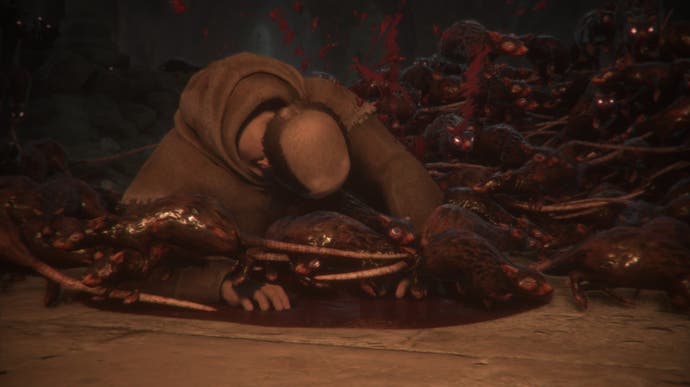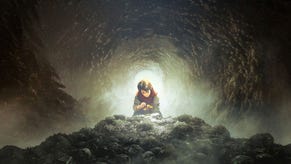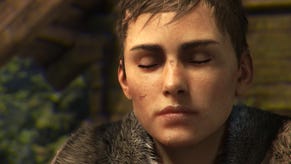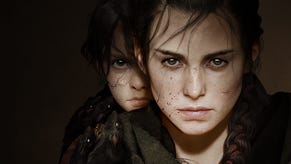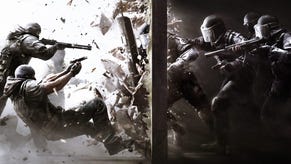A Plague Tale: Innocence versus the Black Death
Beyond rats and mass graves.
How do you tackle one of the most horrific events in the history of Europe in a video game? A Plague Tale: Innocence is set in France in the year 1348 during the beginning of the worst outbreak of the plague, known today as the Black Death, and back in the Late Middle Ages as the Great Mortality. Within just a few years, most of Europe had become decimated by the plague, and many contemporaries believed that the end of the world was at hand. Today, historians estimate that on average around half of Europe's population fell victim to the Black Death.
A Plague Tale isn't shy about bringing us face to face with the inconceivable mass death brought about by the Black Death. Corpses are everywhere, piled up, haphazardly thrown into mass graves or just lying in the middle of the street. If you can stomach a closer inspection, you'll be able to spot the tell-tale black buboes, large swellings in the neck, groin or armpits. These visions are eerily similar to eyewitness accounts of the Black Death, which speak of desolate streets full of death, full cemeteries, and hastily dug pits in which the dead were placed layer upon layer, or, in the words of the contemporary chronicler Marchionne di Coppo Stefani, in the manner of a lasagne.

While impressive, apocalyptic visions of mass death are not enough to express the horror and impact of the Black Death on the lives of individuals and communities. How, for example, would one express the omnipresent and constant threat to one's life or the lives of those around you in a game? Reading historical texts, it becomes clear that it wasn't just the lethality of the pestilence that struck terror into peoples' minds, but also its aggressive and unpredictable spread. It was believed that merely looking at or speaking to a sick person could transmit the disease. The Black Death was an entirely invisible enemy that defied any attempts at comprehension or treatment. Today we know that the plague was most likely caused by fleas carried by black rats, but contemporaries attributed its origin to anything from evil vapours brought forth by earthquakes, to an unlucky conjunction of Mars and Jupiter, to Jews poisoning the wells, to God's anger against the wickedness of mankind.
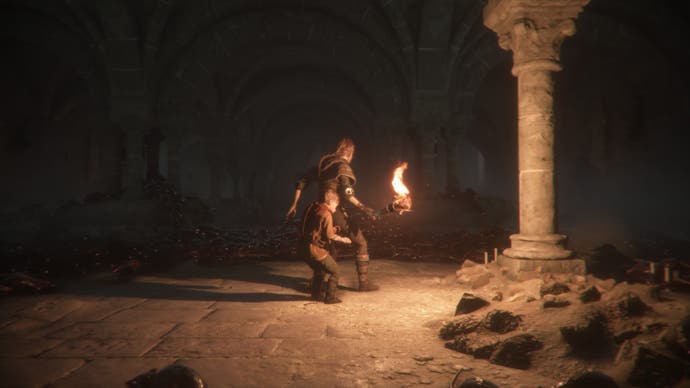
It seems clear that a game in which our protagonist randomly contracts a debilitating and deadly disease would be almost unplayable. A Plague Tale opts for a different approach and tries to make the danger more graspable by materialising the invisible foe in the shape of swarms of rats. In the game, we are told that it is rat bites that transmit the plague, but the only real danger for us as players is the very direct one of being swarmed and devoured within seconds. If the deluge of rats is meant to work as a kind of metaphor or stand-in for the horror and deadliness of the Black Death, it's not entirely successful. If anything, the overwhelming presence of the rats distracts from the plague instead of highlighting it. Then again, the impulse to make the plague more graspable by associating it with 'vermin' is not a new one. The chronicler Giovanni Villani wrote in 1348:
"[A]ccording to some letters from trustworthy citizens of our town who were in the area, such as at Sivas, it rained an immeasurable quantity of vermin, some as big as eight hands, all black and with tails, some alive and some dead. This frightening scene was made worse by the stench that they emitted, and those who fought against the vermin fell victim to their venom."

More problematic, perhaps, is that the immeasurable psychological as well as societal impact of the Black Death is hardly addressed by the game. Amicia and Hugo de Rune's brush with the plague is framed as a thrilling adventure, a harrowing one perhaps, but an adventure nonetheless. Even in the story's calmer moments outside of any immediate danger, its characters are rarely shown struggling with the incomprehensible enormity of the events that surround them. We don't get a sense that countless people were forced to live their lives alongside the plague, to carry on even while watching their neighbours, friends and family members die one by one. It's hard to imagine what 'everyday' life during the Black Death might have looked like. A Plague Tale seems mostly disinterested in the question, instead revelling in apocalyptic imagery, even though there are many evocative historical texts which give an impression of how people tried, or failed, to cope with the plague.
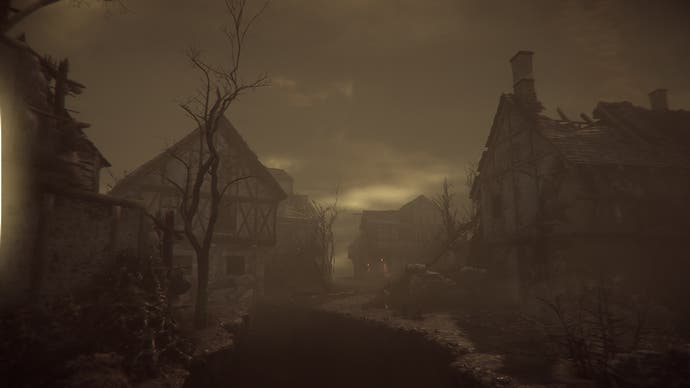
Some of the most affecting accounts can be found in a 1349 letter written by the humanist and poet Francesco Petrarca (better known as Petrarch): "When at any time has such a thing been seen or spoken of? Has what happened in these years ever been read about: empty houses, derelict cities, ruined estates, fields strewn with cadavers, a horrible and vast solitude encompassing the whole world? Consult historians, they are silent; ask physicians, they are stupefied. [...] Will posterity believe these things, when we who have seen it can scarcely believe it, thinking it a dream except that we are awake and see these things with our open eyes? [...] O happy people of the next generation, who will not know these miseries and most probably will reckon our testimony as a fable!"
Even in a general state of numbness and incomprehension, a sense of deep personal tragedy and the traumatic unravelling of a previous order comes through strongly in these accounts. In a heartrending lamentation, Petrarch continued in the same letter:
"Where are our sweet friends now? [...] What abyss swallowed them? Once we were all together, now we are quite alone. We should make new friends, but where or with whom, when the human race is nearly extinct, and it is predicted that the end of the world is soon at hand? We are - why pretend? - truly alone... [...] And behold, even as we speak we too are drifting apart, and we vanish like shadows."
And yet, if contemporary accounts are to be believed, grief and horror were far from the only ways in which people reacted to this terrible new world they found themselves in. In his introduction to The Decameron, the poet and writer Giovanni Boccaccio attested to a behaviour that perhaps seems puzzling to us. Some, he wrote, "maintained that an infallible way of warding off this appalling evil was to drink heavily, enjoy life to the full, go round singing and merrymaking, gratify all of one's cravings whenever the opportunity offered, and shrug the whole thing off as one enormous joke. [...] People behaved as though their days were numbered, and treated their belongings and their own persons with equal abandon. Hence most houses had become common property, and any passing stranger could make himself at home."
Others reacted to the catastrophe in a very different, but similarly conspicuous manner. The unruly flagellants, condemned as heretics by the authorities, went to extreme lengths to placate an angry God. They moved in great numbers from city to city and performed public displays of brutal self-mortification by whipping themselves with iron-tipped flagella. Heinrich of Herford described the practice in gruesome detail:
"With these flagella they beat and whipped their naked bodies to the point that the scourged skin swelled up black and blue and blood flowed down to their lower members and even spattered the walls nearby. I have seen, when they whipped themselves, how the iron points became so embedded in the flesh that sometimes one pull, sometimes two, was not enough to extract them."

Through accounts like these, we can get a glimpse of an evocative, tragic and contradictory picture of life during the plague years; a picture that goes far beyond the rather shallow iconography of corpse piles and gore we find in A Plague Tale. Even though we're in the midst of the plague outbreak and wander through ravaged villages and towns, we're only ever faced with the aftermath, an apocalypse almost completed. There, we encounter no grieving survivors writing letters to distant friends, no bands of people finding solace and purpose in religion or death-defying and reckless hedonism. By the time we arrive at the scene, the anonymous dead have already grown cold, their life's stories extinguished, and all we're left with is empty husks and silence.
(All historical texts and their translations are from John Aberth's book The Black Death: The Great Mortality of 1348-1350.)
